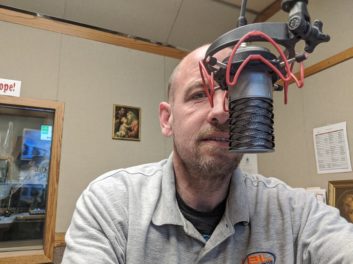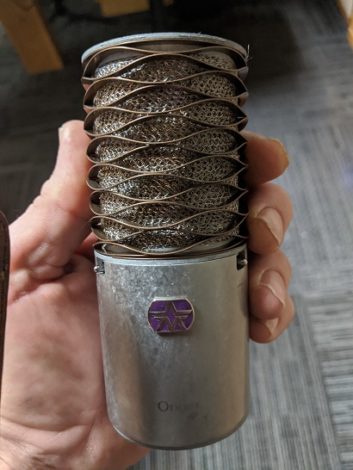As director of operations for Holy Spirit Radio, which operates two non-profit 5,000-watt AM radio stations in the Philadelphia market, I often fixate on achieving quality sound at a low cost.

My best friend since age 3, Jason Lee Sklar, is a DJ at the top-rated Philadelphia Entercom station B101. As you can imagine, there are some major differences in our small AM stations compared to a commercially successful FM like B101. One of the major differences which sounds silly to many but makes a huge difference is the microphones.
Each week, prior to going on the air, Jason shares a selfie on social media. What did I notice? Often not Jason but the shiny Neumann microphone. Top stations, such as B101 or NPR, use the reliable and crisp Neumanns. These microphones are fantastic but often out of the price range for small radio operators such as ours.
Holy Spirit Radio has, like many, used the Shure SM7 and/or Electro-Voice RE20 microphones. These have for many years been standards in the broadcast industry, especially on the AM band. The RE20 was introduced in 1968. The Shure SM7 was introduced in 1972. These are great microphones and they last a long time. I can’t help but wonder if the ones we own are from those original years. More on that in a moment.
These microphones have been perfect for the sound on the AM band, but are we truly AM broadcasters anymore?
Listening has evolved in recent years as younger individuals utilize other methods to listen to their favorite radio content. Many like myself often forgo the typical radio dial and jump to streaming audio via their phones or other devices. Streaming can offer a crisp digital sound compared to the interference that often happens on the AM band.
AFFORDABLE ALTERNATIVE
Two years ago, before some extensive equipment upgrades, I found our sound during live broadcasts to be a little muffled. This was especially noticeable while listening to our live stream. I found it frustrating, but I could not pinpoint the exact cause.

One day, we had extensive noise in our production room, and the cause was some microphone cables. This was not a new occurrence. In the past, we would add filters to fix it, but I wanted a more permanent fix. I decided to run to our local Guitar Center to purchase a few cables in an attempt to clear up the noise.
The plan was to hit Guitar Center, buy the cables and get back out. So often, that is my plan when shopping. But as I walked past the display case of microphones, the salesperson observed me salivating over the Neumann TLM 49. It was similar to the microphone I would see Jason share each week on Facebook.
As the salesman asked if I wanted to check it out, I said, “I would love to, but it’s way out of my price range” (over $1,600). As any good salesperson would do, he asked a few questions, such as, “What is your use?” I think I surprised him when I answered, “Radio station studio.” I answered the question, but was not planning to buy a microphone. He suggested that I look at the Aston Origin microphone, which cost $299.
[Related: “How Should I Disinfect My Microphone”]
The microphone has a very industrial look. Not something you would expect in a radio station studio. I checked it out but resisted the impulse to purchase it and got on with the purpose for my visit.
When I got home, I started to Google the Aston Origin and began reading reviews and understanding more about the microphone itself. The microphone was designed and built in the United Kingdom. The designers wanted to build a microphone that had a unique design, was affordable and built in the UK.
They wanted something that could be unique in the market, yet competitive against the microphones built in places like China. Even some of the best and longest-lasting microphones are now built in cheaper places, such as China.
As soon as the Aston microphone hit the market in 2016, it was a hit, especially with UK bands. As word spread, the brand also became a hit in many other parts of the globe. As I continued to search, reviews started popping up, and comparisons to the Neumann were prevalent on the web.
Many people like to review specs, so here are the specs of the Aston Origin:
- Transducer Type: Condenser
- Acoustic Operating Principle: Pressure Gradient
- Directional Polar Pattern: Cardioid
- Frequency Response: 20 Hz–20 kHz (+/-3dB)
- Equivalent Noise Level: 18 dB A-Weighted
- Sensitivity at 1 kHz into 1 kohm: 23.7 mV/Pa
- Maximum SPL for THD 0.5%: 127 dB
- Signal-to-Noise Ratio (rel. 94dB SPL): 76 dB A-Weighted
- Pad Switch: -10 dB
I am personally not a big fan of all the specs or listing of awards on websites. But what struck me was the awe people had for the natural sound of speech.
Around the same time as I discovered the Aston microphone, I was obsessed with the sound of some of the best content producers. I heard a podcast called “The Pub” (episode #17) that featured NPR engineer Shawn Fox discussing the unique sound of their programs. In the podcast, the engineer credited the Neumann U87 microphone ($3,500). One of the features that Shawn discussed was the bass rolloff switch, cutting off some lower frequencies.

This was important because of the way listeners often hear the radio with background noise, such as with a window down in a car. He made the point that it is not about fixing the noise levels for studio environment, but instead for the listening environment.
As I reviewed the Aston Origin, I noticed that it also has a bass rolloff switch. They also have a higher-end microphone called the Aston Spirit ($449) which, similar to the Neumann U87, also has a second switch to change the polar pattern.
As I connected all this information, it became inevitable that I would soon be trying out these Aston microphones.
QUICK RESULTS
It seems that every time I go to a store like Guitar Center, I get so caught up in looking around and invariably leave without purchasing one of the items on my list and have to make a return trip to the store. On this occasion, since I was going back to the store anyway, I decided to give the Aston Origin a shot, so I bought a microphone.
The next morning, I set up the mic in our production room. It was simply easier to set it up there since the board could provide phantom power easily. At the time (2017), we had a much older board in our main studio.
Then I asked one of our live hosts to cut over to me in the production room during the show. I wanted to see if anyone noticed a difference, but I would also later check out the recording to see if I could hear a difference.
To my shock, people did notice a difference, including an immediate phone call from the head of the station asking why I sounded so much better than the others on the air. I then told him about the experiment. Needless to say, by the end of that day we bought the total supply out of the three area Guitar Center stores. We replaced all our mics.
Just to be clear, there is good reason the Shure SM7B and Electro-Voice RE20 have been standards for so long. It became evident after I replaced our mics that our older mics may have been from one of those early years. We took the time to take them apart, and we found the entire insides to be disintegrated. Based on what we found under the hood, I am shocked they sounded as good as they did. In many ways, I am amazed that they even worked.
Up until about two years ago, we often did not replace older equipment but instead patched it up to keep it running. This microphone replacement kicked off many upgrades, and today, our sound is outstanding over the air and on the streams. Just like these microphones, we attempt to keep costs low, but we also weigh the cost with listener experience as well as ongoing maintenance and longevity. The Aston Origin was very helpful in positioning us with this mindset and well worth the investment we made.
In life and in radio broadcasting, it is easy to be jealous of what others have, but at the end of the day, with the help of others, you can find things that are just as cool but cost far less with very similar and, in some cases, even better results.
[Also by this author: “Be Smart When Thinking About UPS”]












